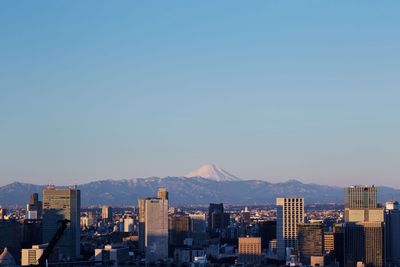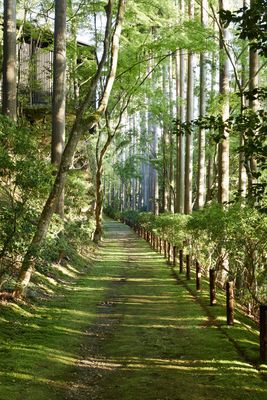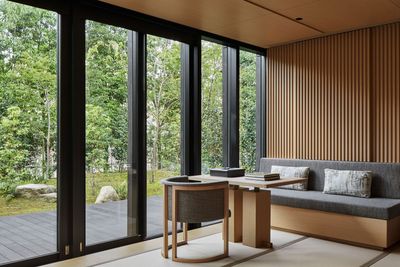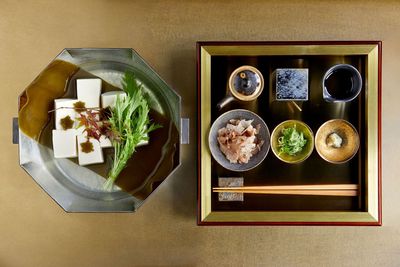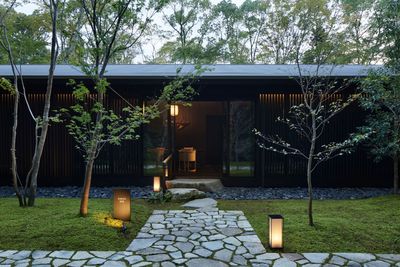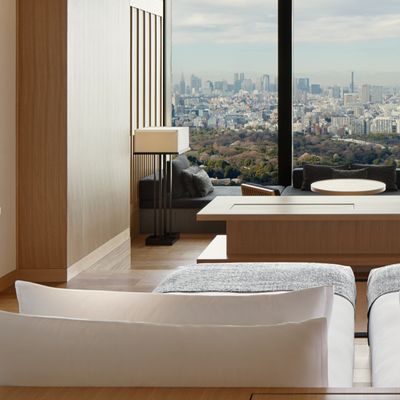

Trips Of A Lifetime: Japan
Post pandemic, Japan officially reopened to tourists from certain “blue” countries (including the UK) last month, though some restrictions remain for now – the main one being that all tourism is limited to fully guided tours with fixed itineraries. Of course, you may want to wait until things are less restrictive, but it is a good idea to get planning and start the booking process, as demand is likely to soar later this year. Whatever your specific interest – be it culture, history, cities, hiking, skiing, beaches or cherry blossom – Japan has it all.
TOKYO
The Lowdown: Tokyo is vast and it’s impossible to sum up this vibrant, constantly buzzing capital city in one paragraph. The first thing to know is that it is made up of a patchwork of different neighbourhoods, each with its own character and atmosphere, so plan in advance which areas you are interested in visiting based on what each one has to offer: for instance, Ginza is the designer centre (think Bond Street); Harajuku is the chic and slightly hipper area (think Notting Hill); Asakusa is the traditional cultural centre; Shibuya is the youth centre, home to the world's busiest pedestrian crossing (see below). And to top it off, the food and drink scene is awesome – Tokyo has the world’s highest concentration of Michelin-starred restaurants. For the latest information on where to eat the best sushi, ramen, tonkatsu refer to Tabelog, the Japanese foodie bible.
Must-sees: Tour operators will have recommendations to suit most interests, as well as organised itineraries on offer. However, should you want to go it alone at a later stage, here are the best places to see and things to do over a couple of days: Meiji Jingu, a popular shrine surrounded by pretty gardens and towering trees; Senso-ji, one of the most popular iconic religious sites in Tokyo and the city’s oldest Buddhist temple; Asakusa district where the narrow lanes are lined with tea houses, restaurants and kimono shops; Kappabashi Dori, or Kitchen Street, a mecca for knives and kitchenware; Harajuku district, a hive of Japanese youth culture and fashion, with small independent shops crammed with a bewildering array of clothes; the ancient Japanese gardens of the Imperial Palace; Shinjuku to see the high-rise buildings and neon lights; Shibuya pedestrian crossing where ten lanes of traffic and five crossroads converge, and more than 1,000 surge across with each change of the lights; the Tokyo Skytree for panoramic views of the city, stretching (on a good day) to Mount Fuji; a sumo tournament. And finally, a cocktail at sunset in a skyscraper is the best way to wind down: head to the 52nd floor at the Park Hyatt in Shinjuku and take in the views from the floor-to-ceiling windows at the bar of Lost In Translation fame.
Where to stay – luxe for less: Expect sleek, contemporary design at the Conrad Tokyo, situated in the top floors of a skyscraper in the heart of the business district but within walking distance of the designer shops in upmarket Ginza and a short taxi ride to the Imperial Palace. Rooms are spacious and modern and have panoramic views over the Hamarikyu gardens and Tokyo Bay.
Where to stay – uber luxe: Situated in the top six floors of the 40-storey Otemachi Tower in the heart of the capital and with spectacular views of the city’s futuristic skyline, Aman Tokyo is the ultimate urban retreat with serene, sleek and minimal interiors. The tranquil spa is the perfect place to relax after a busy day.
HAKONE & MOUNT FUJI
The Lowdown: About 80km west of Tokyo, the landscape turns green and mountainous as you reach Hakone National Park. You can easily come here on a day trip from the capital to enjoy the amazing views of Mount Fuji and enjoy the chance to relax in a hot spring and take a boat trip on the cool blue waters of Lake Ashinoko. However, it’s also a lovely to place to stay over for a couple of nights, sleeping in a ryokan (traditional inn). For the super adventurous, it is possible to climb Mount Fuji during the summer months but if you’re just after a close-up view of the volcanic cone, you can stay on the shore of Lake Kawaguchi.
Must-sees: With several quintessentially Japanese experiences, Hakone National Park’s natural beauty has been attracting visitors for years. Visit the Hakone Open-Air Museum to see masterpieces from modern sculptors such as Rodin and Henry Moore, as well as over 300 pieces by Picasso, including paintings, sketches and ceramics; hike the misty forest trails to visit the Hakone Shrine; visit Odawara Castle; and take a cable car ride over stunning Owakudani, a volcanic valley with active sulphur vents and hot springs.
Where to stay – luxe: The Hyatt Regency Hakone Resort and Spa is located in the heart the park. All the rooms are contemporary in design, and each has either a balcony or sun terrace. A modern restaurant serves delicious French cuisine and Japanese sushi. Leisure facilities include a spa where you can choose from a range of therapies and have access to the onsen (natural hot-spring bath).
Where to stay – uber luxe: Situated in the north of the park and perched next to Lake Kawaguchi at the base of Mount Fuji, Hoshinoya Fuji offers a five-star glamping experience in the depths of a red pine forest. Here, it’s all about nature, with canoeing, riding and star-gazing on offer while staying in one of the 40 ultra chic and modern cabins.
KYOTO
The Lowdown: Take the high-speed Shinkansen bullet train from Tokyo to Kyoto, located in the Kansai region, 226 miles southwest of the capital. Known as the cultural and historic centre of Japan and once the imperial capital of Japan for over 1,000 years, Kyoto was spared the wartime bombings and is full of beautiful ancient temples, colourful Shinto shrines, traditional architecture and peaceful zen gardens. While a modern city today, pockets of historic Japan linger and you will still see kimono-clad geishas shuffling along narrow, lamp-lit streets. It is also famed as the birthplace of traditions like the tea ceremony and flower arranging.
Must-sees: You could easily spend a lifetime exploring Kyoto's historic quarters and serene surroundings but for a short visit, these are our top don't-miss sights and experiences: Kinkaku-ji, the magnificent Golden Pavilion, is one of the most iconic sights – the top two tiers of the temple are gilded in gold leaf; Ginkaku-ji, Kyoto's Silver Pavilion, and the stunning surrounding zen gardens; the famous geisha district of Gion; Fushimi Inari Taisha, the city’s iconic Shinto shrine, with its thousands of torii gates; Nishiki Market for a fascinating insight into Japanese cuisine and a sushi or ramen noodles feast; a traditional matcha tea ceremony.
Where to stay – luxe for less: Situated in the geisha district of Gion in a former teahouse, Sowaka can best be described as a 21st century ryokan (traditional inn). The rooms in the main building overlook an inner courtyard; the more modern annexe houses 12 rooms with city views. A peaceful sanctuary with plenty of atmosphere.
Where to stay – uber luxe: Half an hour north of the city and set in a secret garden at the heart of a forest, Aman Kyoto is the place to stay in totally luxury if you want to escape the busy city but be within a stone’s throw of the spectacular golden temple of Kinkaku-ji. Expect light-filled suites and steaming onsen in the spa.
HIROSHIMA & MIYAJIMA
The Lowdown: Synonymous with the tragic first nuclear bomb dropped during WWII, Hiroshima has risen from the ashes and now has an energetic and cosmopolitan feel to it. A city full of history, the events of August 1945 are sensitively commemorated yet, short of the Peace Park, it’s hard to imagine the destruction caused. The city is thriving, with wide tree-lined avenues and the downtown area is full of shops, karaoke bars and great places to eat – try local specialty okonomiyaki, a savoury cake made from batter, vegetables and noodles which is fried and drizzled with sauce.
The beautiful island of Miyajima (also known as Shrine Island) is a short ferry ride away and well worth a visit. You’ll find a riot of colour from cherry trees and maples in spring and autumn.
Must-sees: The A-Bomb Dome, a Unesco World Heritage Site, marks the place the nuclear bomb was dropped and overlooks the Hiroshima Peace Memorial Park where a flame has burned continuously since 1964 and will remain lit until all nuclear bombs are destroyed; the park is also home to the Peace Memorial Museum which will give you an insight into the devastating attack. Other things to do include a boat trip along the banks of the Motoyasu River and a visit to the reconstructed Hiroshima Castle.
On Miyajima, the centuries old shrine is built over water and located in a small inlet; wander around among the tame deer that roam the countryside; take the cable car to the top of Mount Misen for the views; and dine on oysters.
Where to stay in Hiroshima – luxe for less: Located in the heart of the city near the station, The Sheraton Hotel is very comfortable and the ideal base from which to explore Hiroshima’s sites. It has a choice of restaurants, a large gym and a spa with a wide range of treatments.
Where to stay on Miyajima – luxe for less: Iwaso is a lovely ryokan on the picturesque island of Miyajima, and it’s situated in the stunningly beautiful Momijidani Park. The original part of the inn dates back to 1854. Perfect for seafood lovers – the specialty is oysters and conger eel – this is also the place to stay for authentic Japanese hospitality where you can relax in an onsen overlooking the picturesque forest.
Where to stay – uber luxe: About 30km outside the city, nestled into the hillside overlooking the Sea of Japan and out towards Miyajima island, The Sekitei provide the ultimate ryokan experience. This is a haven of relaxation – the 12 traditionally designed rooms each has a separate living and dining area, relaxation rooms and private onsen baths, as well as incredible views.
KANAZAWA
The Lowdown: Located on the west coast, Kanazawa is often overlooked but is now an easy destination to get to since the bullet train extension opened a few years ago. It’s one of the most pleasant cities to visit in Japan – a nice size, attractive, with a great vibe. Historically a feudal town, there’s a wealth of culture to be discovered in the city temples and castles and, for a modern take, it’s also a respected art centre.
Must-sees: Kanazawa is a pleasure to walk round. The main attractions include the beautiful Kenroku-en Garden (one of the best in Japan) where you can wander past the ponds, waterfalls and bridges that lead to traditional tea houses; the castle; Myoryuji Temple (better known as the Ninja Temple); and the 21st Century Museum of Contemporary Art. Outside of the city, the countryside is rugged, with rice paddies, snow-capped mountains and several onsen. The place to feast on seafood, crab in particular.
Where to stay – luxe for less: Hotel Nikko Kanazawa is a comfortable hotel near the station with wonderful views, spacious rooms and lovely staff, and is an excellent affordable choice for exploring all the sights this city has to offer.
Where to stay – uber luxe: The Relais & Châteaux Beniya Mukayu is in the spa town of Yamashiro, near Kanazawa. Each room has its own private open-air hot spring bath and wonderful views of the authentic Japanese garden. You’ll also find daily traditional tea ceremonies, morning yoga lessons, the finest cuisine and invigorating medicinal spa treatments in this peaceful haven where, it is said, you can expect the best night’s sleep of your life. Beniya has also developed its own wine, coffee, pottery and bath products, so be sure to visit the boutique to stock up on these, as well as gorgeous yukatas (lightweight kimonos).
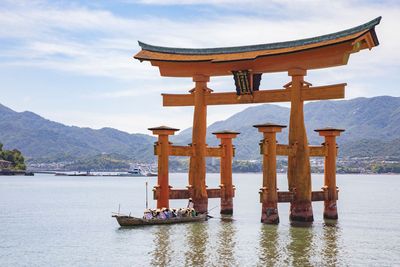
SUGGESTED ITINERARIES
At the moment, you need to employ the services of a tour operator to make your travel arrangements, and most of the best known in the UK include Japan in their programmes. Here are some suggestions to tempt you…
… For Culture
On Cox & Kings’ 10-night ‘Cultural Treasures’ trip, you’ll discover the cultural heritage of Japan through the country’s main island of Honshu. Begin with an exploration of Tokyo and the nearby Hakone National Park, visit the tranquil Kenroku-en garden and the castle of Kanazawa before exploring the imperial city of Kyoto, with its many temples and shrines. Experience the sombre modern history of Hiroshima, then visit the picturesque island of Miyajima with its celebrated torii gate. Finish with a visit to Himeji, famed for its castle and Japanese gardens, before flying home from Tokyo. From £5,495pp, including international flights, 4-star accommodation, some meals, transfers, guided sightseeing and entrance fees, and bullet train travel.
Click here for full details.
… For Foodies
On Intrepid Travel’s 12-day ‘Real Food Adventure’, you’ll travel on a culinary journey through Japan’s most delicious hotspots and get an array of authentic culinary experiences. Travelling from Tokyo to Takayama, Osaka, Koya-san and Kyoto, you’ll also learn to master the art of sushi-making, savour the flavour of sizzling yakitori in Tokyo's hidden backstreet bar, spot geisha in Kyoto’s Gion district and feast on all the freshest seafood, tempura, sashimi you can handle. From £3,464pp, excluding international flights, accommodation, most meals, experiences and transfers.
Click here for full details.
…The Grand Tour
On Audley’s 22-day ‘Grand Tour’, highlights include Tokyo, Hiroshima, Hakone and Kyoto; walking Nakasendo Highway between Tsumago and Magome; visiting Kanazawa's beautiful Kenroku-en garden; staying in a traditional Buddhist temple lodging; spotting geisha in Kyoto with an expert guide. From £8,620pp, including international flights, luxe accommodation, transfers, activities and excursions.
Click here for full details
WHEN TO GO
The best time to visit Japan is during spring (March to May) when the cherry blossom is out and autumn (September to November) when the autumn leaves are at their most striking. The rainy season occurs from the end of May until the middle of June or July, though it’s the ideal time for hiking in the Japanese Alps and Hokkaido’s national parks. For winter sports in the north of Japan, January and February are the best months.
DISCLAIMER: We endeavour to always credit the correct original source of every image we use. If you think a credit may be incorrect, please contact us at info@sheerluxe.com.
